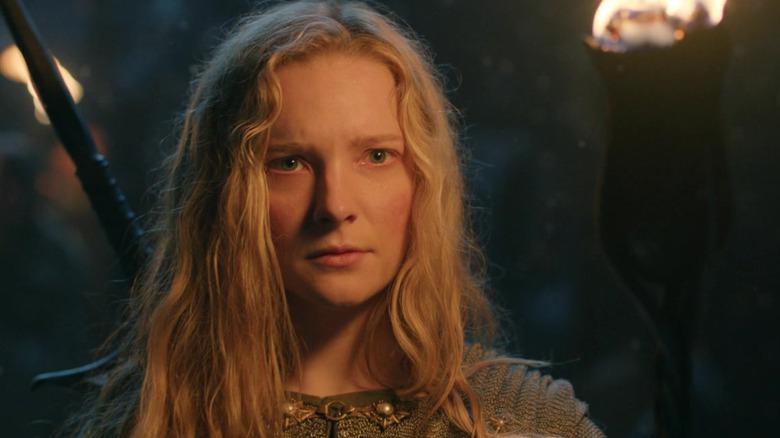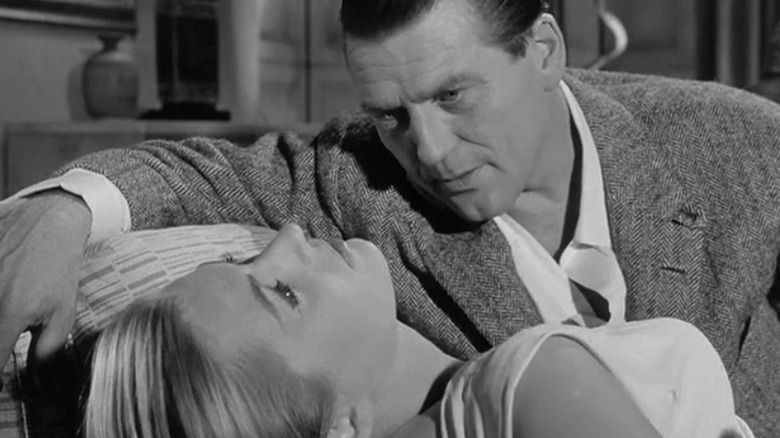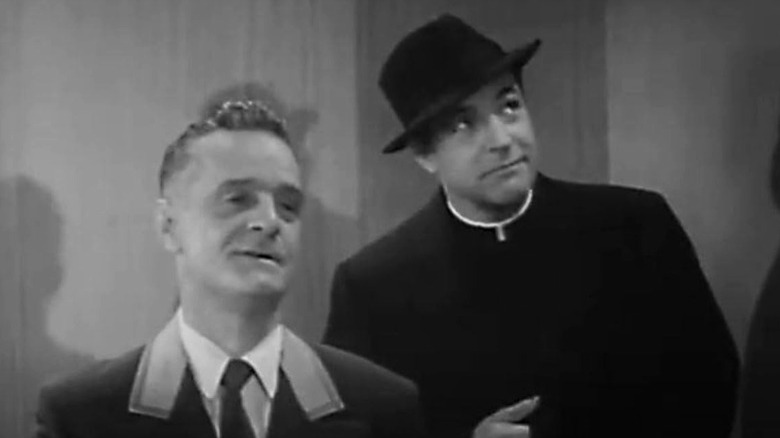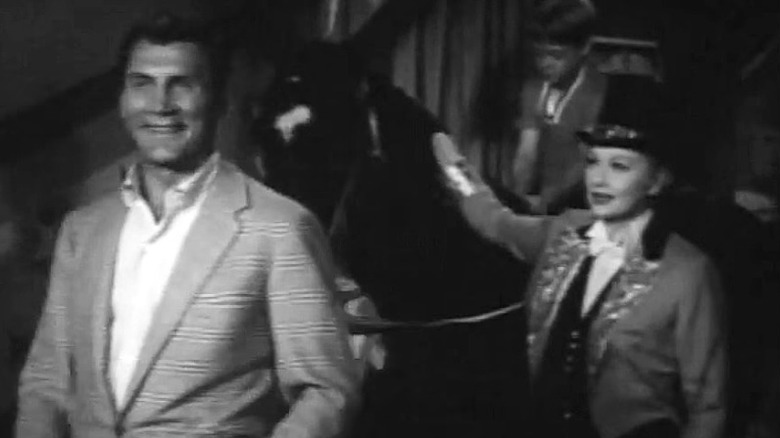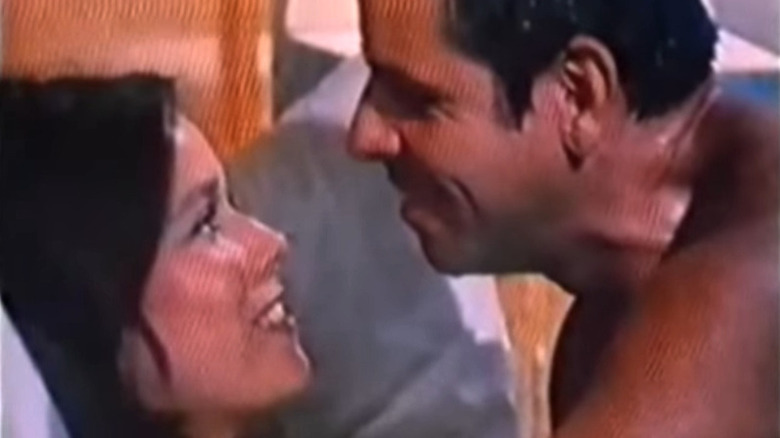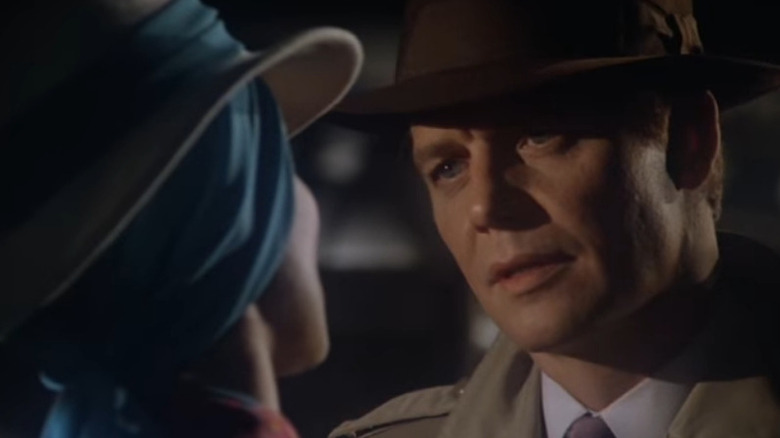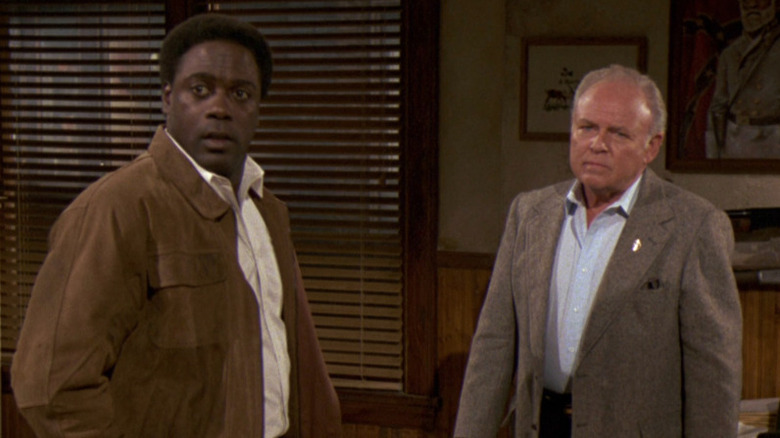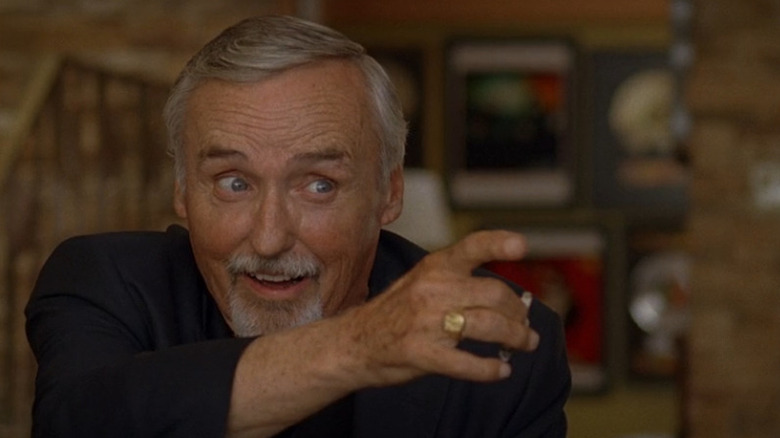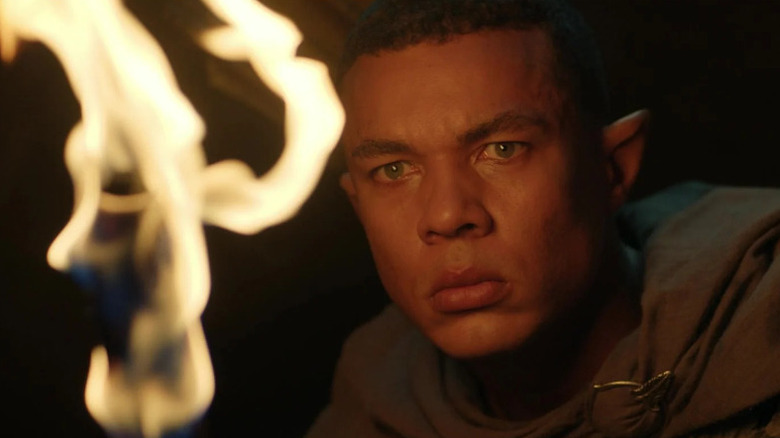These Are The Only Seven Best Picture Winners That Were Turned Into TV Shows
Movies and television have been competing for the same audience's time and money since TV was invented, but they've also formed a strange symbiosis. There have been a heck of a lot of movies based on TV shows, and a heck of a lot of TV shows based on movies.
Some of those shows based on movies have been major pop culture milestones, like "Buffy the Vampire Slayer," "The Karate Kid," and "Friday Night Lights." And of course a whole lot of been almost completely forgotten, like the sitcoms based on "Dirty Dancing," "Working Girl," and "Animal House."
But one thing these TV shows usually have in common is that they're almost always based on a hit movie. (Okay, okay, "Buffy" was a big exception.) It's not surprising when a blockbuster like "M*A*S*H" or "Honey, I Shrunk the Kids" gets turned into a television series. It's even common for smaller, but critically acclaimed films like "Fargo" to get their own show sometimes.
So it's a little surprising that, in the nearly 100-year history of the Academy Awards, only seven Best Picture Oscar winners have ever been turned into TV shows. And the Best Picture winners that made the jump from the big screen to the small screen are probably not the ones that you'd expect.
Let's take a closer look at the eight TV shows that have been made out of these seven movies.
Casablanca (1955-1956)
Michael Curtiz's "Casablanca" is one of the most beloved movies in history. Even people who have never seen it know the quotes: "Here's looking at you kid," "Round up the usual suspects," "This looks like the beginning of a beautiful friendship." So it's not surprising that "Casablanca" was the first Best Picture winner to get its own TV series. It's not even surprising that it got two of them. But it's a little surprising that they were both duds.
The first "Casablanca" TV show came in 1955 in the wheel series "Warner Bros. Presents." The idea of a wheel series is that it takes up one time slot but alternates between multiple shows. In the 1970s, for example, in the first season of "The Hardy Boys/Nancy Drew Mysteries," you'd get a Hardy Boys episode one week and a Nancy Drew episode the next. One of the shows "Warner Bros. Presents" presented was a series that followed Rick Blaine, Humphrey Bogart's character from the classic World War II drama, as he continued to run his nightclub in the 1950s and got involved in Cold War spy intrigue.
Bogart, who obviously wasn't going to do this show, was replaced by Charles McGraw ("Narrow Margin"), and Clarence Muse ("Porgy and Bess") took over the role of the pianist Sam, originally made famous by Dooley Wilson. Guest stars included Maureen O'Sullivan and Anita Ekberg, and Warner Bros. bumped up the celebrity factor by interviewing stars like Gary Cooper and Liberace in the show's wraparound segments, to promote the studio's other projects.
This version of "Casablanca" lasted only ten episodes, but after learning that, you may be surprised to learn that of the two "Casablanca" TV shows, this one was by far the most successful.
Going My Way (1962-1963)
The second Best Picture winner to get its own TV series, weirdly enough, was the film that won Best Picture right after "Casablanca." Bing Crosby won the Best Actor Oscar for "Going My Way," playing a spirited and modern Catholic priest who tries to help his community and warm the heart of his conservative predecessor. The role of the curmudgeonly older priest was played by Barry Fitzgerald, who was also the only person ever nominated for Best Actor and Best Supporting Actor for the same role in the same film.
While Humphrey Bogart was replaced by a less famous actor in the "Casablanca" series, in "Going My Way" the casting was a surprisingly lateral move. Gene Kelly, the star of the Best Picture winner "An American in Paris" and other classics like "Singin' in the Rain" and "Anchors Aweigh," took over the Crosby role as the young priest with contemporary ideas. Leo G. Carroll ("Spellbound") took over the Barry Fitzgerald role.
Unlike the first "Casablanca" series, "Going My Way" wasn't a sequel, and instead stretched out the original movie's premise. Every week the two priests encountered a bit of drama with their parishioners, with the assistance of a new character who runs a youth center, played by Dick York ("Bewitched"). It was the only episodic TV series Gene Kelly ever starred in, and although it lasted just one season, it featured some impressive guest stars, like Ellen Burstyn, George Kennedy, Cloris Leachman, and Eddie Bracken.
The Greatest Show on Earth (1963-1964)
Time plays tricks on us all. Cecil B. DeMille's "The Greatest Show on Earth" may have won the Best Picture Oscar, and may have even been the highest-grossing film of 1952, but nowadays it's probably best known for being one of the worst movies to ever win the top Academy Award, and for being the movie Steven Spielberg's avatar Sammy Fabelman watched in the opening scene of "The Fabelmans."
But although time hasn't been especially kind to Cecil B. DeMille's ambitious circus epic — and the fact that it won Best Picture over "High Noon" will always make it look like a weird choice from the Academy — it really was a major blockbuster when it first came out. It's not terribly surprising that it spawned its own TV series, even though it only lasted one season.
"The Greatest Show on Earth," the series, starred future Oscar-winnerJack Palance ("City Slickers") as Johnny Slate, the head of a traveling circus who looks and sounds and acts a lot like Charlton Heston's character from the original film, but has a different name. Over the course of the series, he and his circus would run into new dramatic shenanigans every single week, usually involving notable guest stars like Lucille Ball (who also produced the series), Ellen Burstyn (again!), Buster Keaton, Ricardo Montalban, James Coburn, and Dennis Hopper (who will be back in this article).
Whether it was the "greatest show" or not, this Best Picture series suffered from a tough time slot, competing with the hit comedies "Petticoat Junction" and "The Jack Benny Program." Under those circumstances, the fact it lasted a full season, 30 episodes total, can only be considered a minor miracle.
From Here to Eternity (1980)
For a long time it was pretty common for classic movies to get remade on television with lower budgets and new stars. "Miracle on 34th Street" alone had three TV remakes between 1955 and 1973. Marlo Thomas ("That Girl") took over the lead role in "It's a Wonderful Life" from James Stewart in a gender-swapped TV remake called "It Happened One Christmas." And the Best Picture Winner "From Here to Eternity" became a star-studded TV mini-series in 1979, starring William Devane ("Rolling Thunder"), Natalie Wood ("West Side Story"), Kim Basinger ("L.A. Confidential"), Joe Pantoliano ("The Matrix"), Steve Railsback ("The Stunt Man"), and Peter Boyle ("Young Frankenstein").
The mini-series was successful enough that in 1980, NBC debuted a new weekly primetime show that took place immediately after the final scenes, featuring the same cast. Well, some of them. The characters played by Railsback, Pantoliano and Boyle all died at the end of the original story, so they didn't come back. Railsback and Boyle even had to be recast in the pilot episode so the show could walk new audiences through what they missed in the mini-series. Also, Natalie Wood didn't commit to a series and was replaced by Barbara Hershey ("The Stunt Man"). And with one of the key protagonists of the original "From Here to Eternity" dead, the show clumsily introduced his handsome brother, played by Don Johnson ("Miami Vice"), who just happens to get assigned to the same military base at the start of World War II.
"From Here to Eternity" was, like most of the shows based on Best Picture winners, not a hit with audiences. NBC canceled the series after just five episodes, and then burned off the remaining installments as TV movies during the month of August, back when networks mostly showed reruns all summer.
Casablanca (1983)
Remember how the first "Casablanca" TV series lasted only ten episodes? The second "Casablanca" series didn't get nearly that far. NBC pulled this full-color version from the air after only three episodes. Like "From Here to Eternity," the remaining finished episodes were burned off later that summer. Unlike "From Here to Eternity," there were only three of them.
This new "Casablanca" was a prequel series, starring David Soul ("Starsky and Hutch") as Rick, who runs his night club in Casablanca in the years leading up to World War II. Joining him in the main cast were the legendary Scatman Caruthers ("The Shining") as Sam, Hector Elizondo ("Pretty Woman") as Captain Renault, and a young Ray Liotta ("Goodfellas") as the bartender, Sasha. Every week Rick would try not to get roped into crime and/or revolutionary intrigue, and every week he'd begrudgingly end up helping the good guys in some way.
The second "Casablanca" series wasn't a total dud. In fact, it won an Emmy Award for its cinematography. There weren't as many superstar guest actors this time around, but you can find Persis Khambatta ("Star Trek: The Motion Picture") in the show's fifth and final episode, "Divorce, Casablanca Style" as a woman sentenced to death when she is falsely accused of having an affair with Rick.
In the Heat of the Night (1988-1995)
Of all the movies based off of movies that won the Oscar for Best Picture, none has been a bigger hit than "In the Heat of the Night." Most of the shows on this list didn't last more than a single season (if that), while "In the Heat of the Night" ran for seven seasons. That's 147 episodes. Plus four TV movie sequels. By any measure, it's a pretty dang successful show.
To be fair, it's based on a popular and incredibly successful movie. "In the Heat of the Night" starred Sidney Poitier in an astounding role as a Philadelphia cop who gets swept up in a murder mystery in a deeply racist small town in Mississippi, where he has to contend with a bigoted local sheriff, played by Rod Steiger, to solve the crime. In addition to winning five Academy Awards, "In the Heat of the Night" also spawned two successful sequels, "They Call Me Mister Tibbs" and "The Organization," also starring Poitier.
The TV series stars Howard Rollins ("A Soldier's Story") in Poitier's role, and Carol O'Connor ("All in the Family") in the Rod Steiger role. (O'Connor won an Emmy for the same role that won Rod Steiger an Oscar.) Over the course of the series, tumultuous behind-the-scenes events eventually led to O'Connor taking over as the producer of the series, with a writing credit on 27 episodes. The series tackled hard-hitting social issues and featured guest performances from a cavalcade of prominent actors, like Louise Brooks, Walton Goggins, Mariska Hargitay, Peter Fonda, Tippi Hedren, George C. Scott ... and even O.J. Simpson.
Crash (2008-2009)
It took over a decade for another Best Picture winner to get its own TV series, and when it happened, it was for "Crash," of all things. "Crash" was the directorial debut of Paul Haggis, the creator of the TV shows "Due South" and "Walker, Texas Ranger," who became a Hollywood hit machine in the 2000s, writing screenplays for the Best Picture winners "Million Dollar Baby" and "Crash," as well as co-writing "Casino Royale," the film that successfully rebooted the James Bond franchise.
If you're wondering what ever happened to Paul Haggis, he was found legally liable for very serious "Me Too" allegations. So it's deeply uncomfortable when the TV series based on "Crash" begins with Dennis Hopper ("Easy Rider") playing an entertainment industry mogul who exposes himself to his limo driver and tries to talk her out of suing him, before cruelly berating her as if he's the aggrieved party. Admittedly, the movie wasn't any more subtle from a dramatic perspective, but the parallels are distracting and disturbing.
Like the film, the series took place in Los Angeles and told a series of overlapping stories about seemingly disparate characters, all of whom are deeply flawed and often very racist. Although it debuted to mixed reviews and little fanfare, this STARZ original series was a pretty big hit as far as these Best Picture TV shows go. It lasted two whole seasons!
The Lord of the Rings: The Rings of Power (2022 - ???)
The most ambitious TV series ever based on a Best Picture winner, and by far the most costly, is Amazon's "The Lord of the Rings: The Rings of Power." It cost Amazon about a billion dollars for the rights to produce five seasons of this prequel to J.R.R. Tolkien's novels and Peter Jackson's live-action films. (If you can think of a more expensive TV show, please let us know.)
Like the 1980s "Casablanca" series, "The Lord of the Rings: The Rings of Power" takes place prior to the events of the Best Picture winner, "The Return of the King." Unlike the second "Casablanca" TV show this series takes place thousands of years earlier, and tells the story of the future elf queen Galadriel (Morfydd Clark, "Saint Maud") and the future world-conquering despot Sauron (whose identity is supposed to be a secret for a while, but to be fair it isn't much of a mystery). Fortunately for the showrunners, J.R.R. Tolkien cataloged the history of Middle-earth in detailed appendices, so the show has been able to stay largely true to the established canon.
It also stays largely true to the look of the films, even though Jackson isn't involved in the series. The appearance of Middle-earth and established characters like Galadriel are generally in keeping with the blockbuster movies, so although you could argue the series is more of an adaptation of Tolkien's work than the films, they're clearly trying to keep fans who only know the movies comfortable by maintaining a sense of visual continuity.
As of the writing of this article, it's unclear whether "The Rings of Power" will last the full five seasons, but Amazon paid a whole freakin' lot for the rights to produce them, so there's a good chance this series will be one of the rare Best Picture TV shows that goes the distance.
